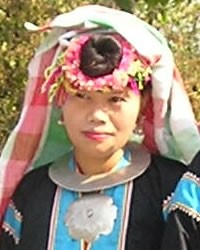Lahu Aga in Laos

Photo Source:
Anonymous
|
Send Joshua Project a map of this people group.
|
| People Name: | Lahu Aga |
| Country: | Laos |
| 10/40 Window: | Yes |
| Population: | 10,000 |
| World Population: | 10,000 |
| Primary Language: | Lahu |
| Primary Religion: | Ethnic Religions |
| Christian Adherents: | 8.50 % |
| Evangelicals: | 7.90 % |
| Scripture: | Complete Bible |
| Ministry Resources: | Yes |
| Jesus Film: | Yes |
| Audio Recordings: | Yes |
| People Cluster: | Tibeto-Burman, other |
| Affinity Bloc: | Tibetan-Himalayan Peoples |
| Progress Level: |
|
Introduction / History
Approximately 7,000 or more Lahu Aga live near the Mekong River in the Tonpheung districts of Bokeo Province and Vien Phu Kha area. They will say they are Lahu Na or Black Lahu, but this small people group is very different from the Black Lahu in China, Burma and Thailand. Other groups in Laos call them Kui. In further discussions they will admit they are actually Lahu Aga. The origin of this name is not clear and only 2 similar villages can be located in China. There are well over 10,000 Lahu in Laos of the Yellow, White and Aga types. The majority of Lahu (more than 500,000) live in southwestern China. Over 100,000 Lahu live in Myanmar, Thailand and 5,400 in Vietnam.
The Lahu have the reputation for being probably the most isolated and unassimilated ethnic group in northern Laos. They prefer to stay in their remote mountain communities at heights often more than 1,400 meters (4,590 feet) above sea-level. According to the 1995 census, only 1.6% of Lahu in Laos are able to read, including a mere 0.4% of women. A staggeringly high 96.3% of Lahu have never attended school, even at primary level, including 98.6% of Lahu women. Among all of the peoples of Laos, only the Akha have comparable statistics for education and literacy.
The Lahu Aga, who speak a distinct language from the other Lahu groups in Laos, are/were animists. Each village has/had at least one shaman, who leads the village in animistic spiritual matters. There is also a belief in a Creator God, G'ui Sha. They had turned to worshiping the Sun and the Moon in some places because they didn't know who G'ui Sha was or how to worship him. The Lahu's belief in a Supreme Being has greatly facilitated their turning to Christianity. Early missionaries found many Biblical stories already paralleled in Lahu beliefs and legends.
The first recorded ministry to Lahu in Laos took place in 1892, when famous Presbyterian pioneers William Clifton Dodd and Daniel McGilvary preached to them. Daniel McGilvary reported, "I found on approaching him that he was not a Muso [Lahu], but a Kui-of a tribe which we had planned to visit later.... The village was a large one, as mountain villages go, of twenty-five or thirty houses, and from two hundred and fifty to three hundred souls-in general not unlike the [Lahu] villages we had seen. The Kui language also, while different from [Lahu], is cognate with it..Their visit to Laos, predates the well-documented mass conversions to Christ which took place among the Lahu in Burma and China in the early 1900s. Their visits to Laos proved fruitless and after 3 difficult trips they stopped their attempts to reach the Lahu in Laos. Until recently the Lahu Aga remained chained in darkness. There are now around 600 Lahu Aga believers in Laos, possibly more.
Although they may be related to the Kucong in China, there are cultural, ethnic and linguistic differences between the two groups. Originally, both the Kucong and Lahu Aga were part of the Lahu in southern China. The Lahu Aga have been one of Asia's most isolated people groups. In China, when Communist cadres found them in the 1950s, they were on the brink of extinction.
Prayer Points
Thank God for the mass conversion of Lahu to Christ in each of the nations they live.
Ask God to give the Lahu church a vision to reach other ethnic groups.
Pray the Lahu Na church would be strenghened and empowered to reach out to those less fortunate than them.